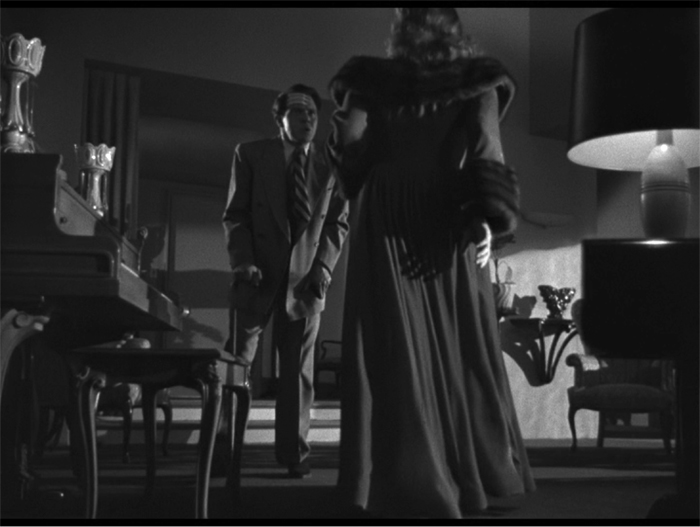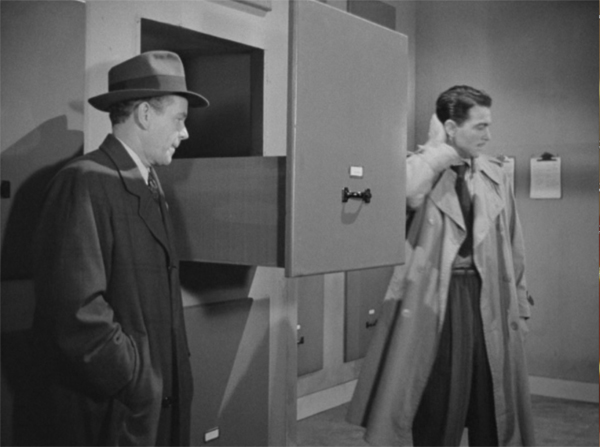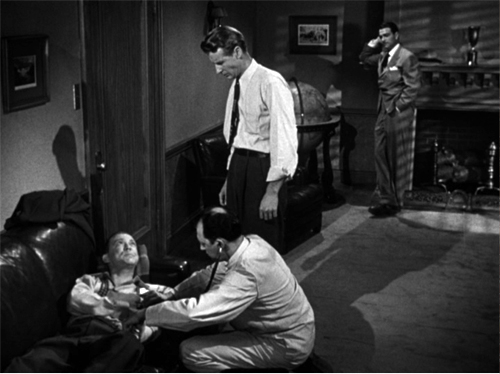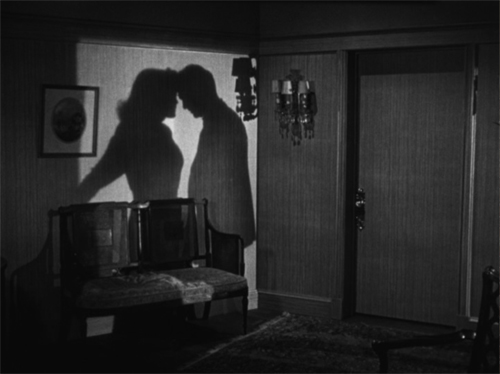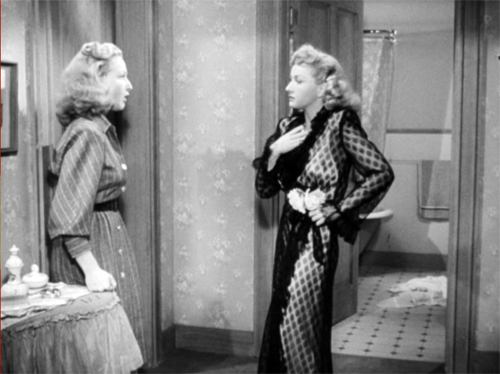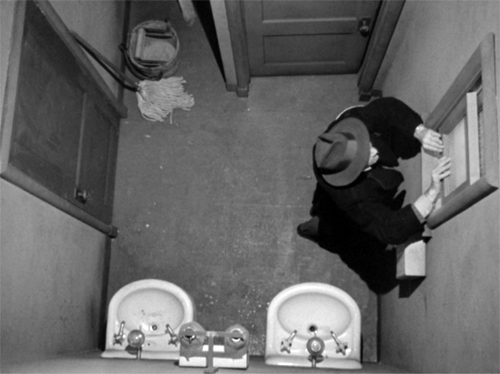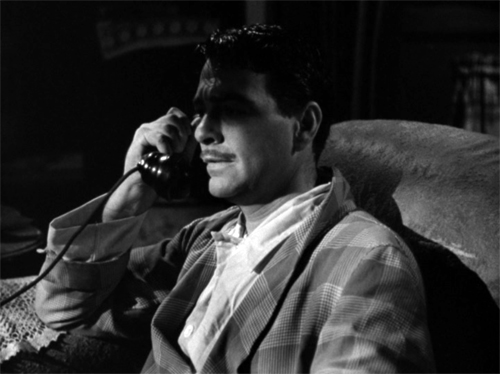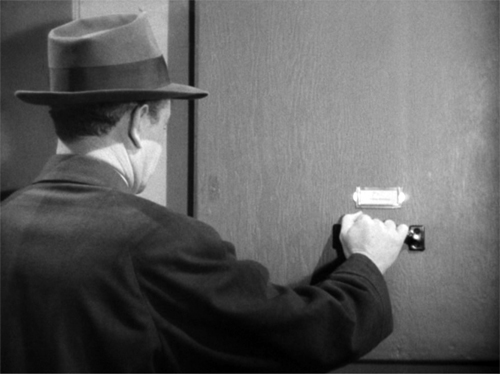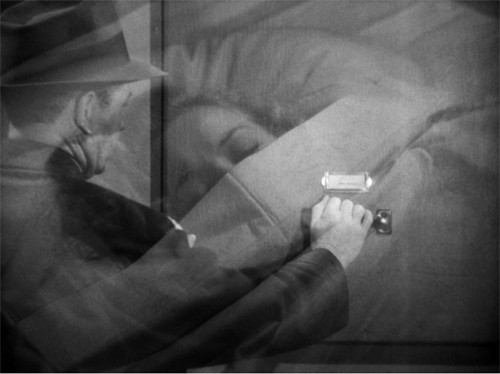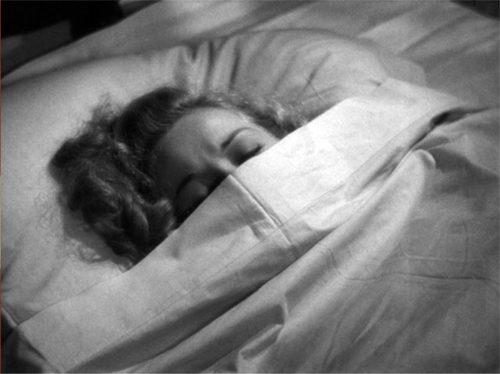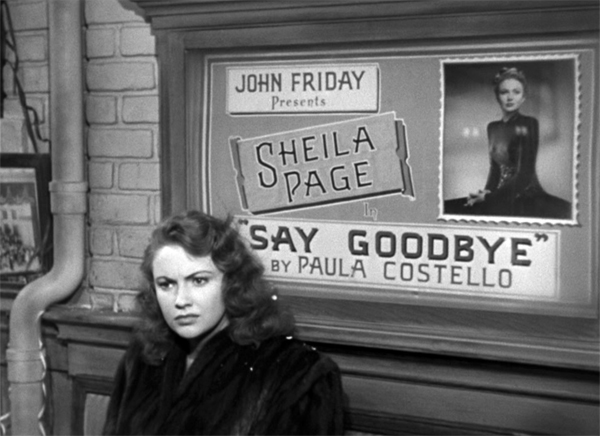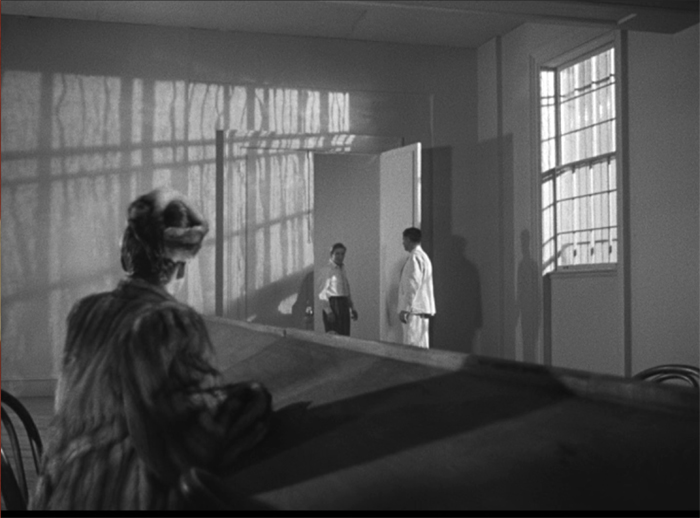Repeat Performance (1947).
DB here:
For several years, the Film Noir Foundation [2] has initiated recovery and restoration of a great many neglected films, mostly from Hollywood. Thanks to Flicker Alley [3], several of those have made their way to DVD and Blu-Ray. (Earlier blog entries have considered the editions of Trapped [4] and The Man Who Cheated Himself. [5]) Now come two more discs, with beautifully restored copies and informative supplements.
The Monogram Touch
The Guilty (1947).
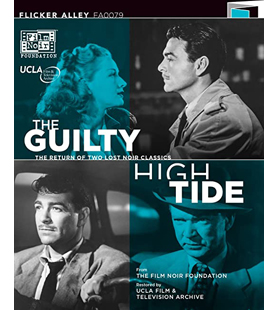 [7]A generous double-feature disc displays what smooth B-filmmaking can look like. High Tide (1947) tells of Tim Slade, a rogue reporter brought back to work under his tough editor, Hugh Fresney. Fresney wants Tim’s help in taking on the city’s crime syndicate. Tim’s position is complicated by his past affair with the wife of the paper’s publisher, who’s hesitant to challenge the mob. A secret file on the gang becomes the target of Tim’s investigation, leading to an amiable former reporter Pop Garrow. The reversals pile up and lead to a surprise revelation at the climax.
[7]A generous double-feature disc displays what smooth B-filmmaking can look like. High Tide (1947) tells of Tim Slade, a rogue reporter brought back to work under his tough editor, Hugh Fresney. Fresney wants Tim’s help in taking on the city’s crime syndicate. Tim’s position is complicated by his past affair with the wife of the paper’s publisher, who’s hesitant to challenge the mob. A secret file on the gang becomes the target of Tim’s investigation, leading to an amiable former reporter Pop Garrow. The reversals pile up and lead to a surprise revelation at the climax.
A noteworthy feature is a significant gap in a key scene. I can’t say more here, but the audio commentary by Alan K. Rode explains that although the complete scene is in the script, every print he has seen contains this omission. He speculates it might have been cut to shorten running time. I also wondered whether, since the print is a British one, the portion might have been snipped for censorship reasons. Interestingly, the AFI plot synopsis includes the scene. But 1947 sources give the original running time as 70 minutes, the same as the version we have, so the mystery remains.
Like other 1940s films, High Tide has a crisis structure. It starts with Tim and Fresney trapped in a car about to be swamped by the incoming tide. We then flash back to the events leading up to that. Director John Reinhardt and cinematographer Henry Sharp give us crisp, no-nonsense scenes making flexible use of depth staging (often to set Tim off as observer) and offering the occasional eye candy.
The main attraction on this double bill is The Guilty. It’s based on a Cornell Woolrich story, first titled “He Looked Like Murder” and republished as “Two Fellows in a Furnished Room.” As with most Woolrich adaptations, the film changes the original considerably. Mike Carr’s roommate Johnny Dixon is accused of murdering Linda Mitchell, twin sister to Estelle (Bonita Granville in a dual role). Dixon goes on the run while Carr investigates and maintains his rough-edged affair with Estelle.
Woolrich’s story doesn’t give us twin sisters or a romantic plot; the emphasis falls on Carr’s disintegrating relation with his roommate. The clues are much the same, but the film adds a flashback structure, with Carr narrating past events to a bartender (and us) as he waits for Estelle. The short story’s solution is predictable, while the film offers a twist ending, heightened by a nifty slippage of that voice-over.
The film’s plot sacrifices coherence for its surprise finale, but the overall result is pretty impressive for a two-week shooting schedule. Out of a few cheap sets, Reinhardt and Sharp create a varied range of angles and modulated lighting.
The film is exceptionally free of gunplay and other violence, but that lack is made up by a remarkable scene in a morgue. The police detective is describing to Carr how Linda was killed. As he stands by the mortuary drawer, his dry account of the grisly murder is chilling. (Once more, sometimes telling beats showing [13].) It’s close to the same scene in the original story. As Eddie Muller indicates in his introduction, it’s the most shocking scene in the film.
The Guilty also spares time for images that foreshadow the outcome, as in ominous high angles of a street. There’s also the sort of evocative superimpositions that Hollywood occasionally supplies. A purely functional shot of the morgue drawer sliding shut dissolves to a shot of Estelle in bed, at once substituting for her sister and looking ahead to her as a possible victim.
The Guilty typifies the sort of film that deserves to be recognized as a part of a fine Hollywood tradition—the well-made B. I had never seen it or High Tide before, and they reminded me of what could be done at the studio that also gave us the Bowery Boys, Dillinger (1945), and King of the Zombies (1941).
The future’s gonna change
Calling Repeat Performance (1947) a film noir illustrates how elastic the label has become. Yes, it begins with a murder in the manner of Mildred Pierce (1945). There’s a flashy use of chiaroscuro at its climax (surmounting this entry). It’s directed by the elusive Alfred Werker, who signed the woman-in-peril thriller Shock! (1946) and was involved with He Walked by Night (1948). But as Daily Variety’s review pointed out, it’s less a crime story than a “suspense melodrama.” And it traffics in supernatural explanations.
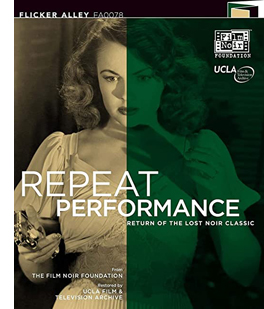 [18]Eddie Muller’s introduction points out that a noir like Night Has a Thousand Eyes (1948) also invokes otherworldly forces. But like the Guilty adaptation, the source has been heavily altered. William O’Farrell’s novel Repeat Performance is told from the viewpoint of a man being hunted for strangling his wife. It’s a thriller more closely tied to the conventions of what we think of as noir. By switching the action to the viewpoint of the wife, and eliminating the police pursuit, the film gives us something closer to another cycle of the 1940s.
[18]Eddie Muller’s introduction points out that a noir like Night Has a Thousand Eyes (1948) also invokes otherworldly forces. But like the Guilty adaptation, the source has been heavily altered. William O’Farrell’s novel Repeat Performance is told from the viewpoint of a man being hunted for strangling his wife. It’s a thriller more closely tied to the conventions of what we think of as noir. By switching the action to the viewpoint of the wife, and eliminating the police pursuit, the film gives us something closer to another cycle of the 1940s.
During that decade, filmmakers continued a Hollywood vein of fantasy—most obvious in the ghost films that proliferated, but also in tales of divine intervention by angels and other forces. Here Comes Mr. Jordan (1941) and It’s a Wonderful Life (1946) visualize alternative futures for their protagonists. Portrait of Jennie (1949) suggests a time stream operating alongside that of normal life, and some films with prophetic dreams suggest that the characters’ fates are determined.
Other media dabbled in the alternative-universes premise. Most famously, J. B. Priestley experimented with forking-path plots in the play Dangerous Corner (1932). (I talk about the film version here [19].) His later dramas, such as Time and the Conways (1937) and I Have Been Here Before (1937), pursue parallel timelines, but the closest to Repeat Performance, I think, is his remarkable “mystery” An Inspector Calls (1945).
It’s no spoiler to say that the plot of Repeat Performance restarts the time scheme of the action. On New Year’s Eve, as 1947 starts, the actress Sheila Page shoots her husband Barney. But as she leaves the murder scene, she enters the world a year earlier, on the first day of 1946. As the voice-over narration explains, she will relive that year.
After Sheila understands that she has a reprieve, she sets out to change the events that led up to her crime. She tries to keep Barney sober and focused on writing his next play, and above all she struggles to keep her rival Paula Costello away from him. She wants, she says, to “rewrite the third act.” Yet even when she changes the circumstances, accidents intervene to block her efforts. She fears that the onset of 1947 will drive her to kill again. Can she thwart destiny?
The result yields a satiric portrait of Broadway backstabbing, while cleverly suggesting that the changes in Sheila’s future are like revisions of a play in production. During a rehearsal, she suggests improving Act II by “playing it backwards”—that is, putting the scenes in reverse order. Yet they yield the same consequences, just as she will learn that her fate doesn’t care about the particular patterning as long as “the result is the same.”
Like Back to the Future (1985), the film is a time-travel adventure that aims to reset the past. It reminds us that a lot of modern movie storytelling consists of shrewd revisions and updatings of premises that had their sources in earlier Hollywood periods—particularly the 1940s. Fans of The Twilight Zone will have fun with Repeat Performance.
The Film Noir Foundation’s releases abound in no-nonsense supplements. They’re full of historical background to the films, the companies, and the personnel. On these two discs we get a detailed study of producer Jack Wrather, a rich account of the Eagle-Lion company, career summaries of Cornell Woolrich, John Reinhardt, Lee Tracy, and Joan Leslie, a pressbook for Repeat Performance, and informative liner notes. These put us in the debt to filmmaker Steven C. Smith and film historians Alan K. Rode, Eddie Muller, Imogen Sara Smith, Farran Smith Nehme, Brian Light, and many interviewees. Not only the films but the bonus materials are excellent additions to a cinephile’s collection.
The Daily Variety review of Repeat Performance is in the issue of 23 May 1947, p. 3. For my take on Cornell Woolrich and cinema, go here [20]. I discuss Repeat Performance along with other fantasy-laden films of the period in Reinventing Hollywood: How Filmmakers Changed Movie Storytelling, chapter 9.
Repeat Performance (1947).
